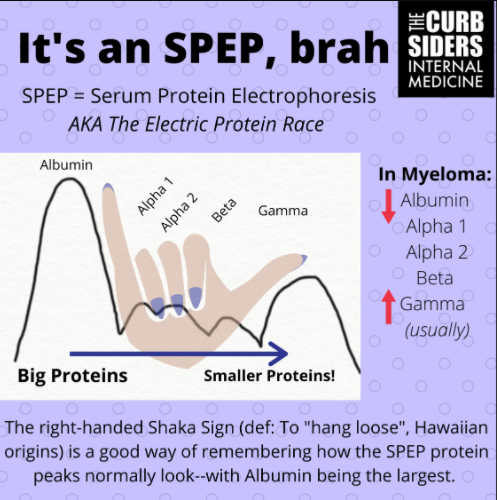In addition to this post on Curbsiders #247, I’ve also linked to and reviewed the following from emedicine.medscape.com:
- Serum Protein Electrophoresist [SPEP] Updated: Jul 31, 2019
Author: Sherilyn Alvaran Tuazon, MD; Chief Editor: Eric B Staros, MD - Immunofixation
Updated: Jul 29, 2019
Author: Anastasios Dimou, MD - Immunoglobulins
Updated: Sep 24, 2020
Author: Rakesh Vadde, MBBS - Quantitative serum immunoglobulin tests
Volume 42, No.4, April 2013 Pages 195-198 [Link To PDF] from The Australian Family Physician
In this post I link to and excerpt from the outstanding Curbsiders‘ episode #247 SPEP It Up* [Link is to the podcast and show notes]. DECEMBER 21, 2020 By NORA TARANTO:
*SPEP is the abbreviation for serum protein electrophoresis.
Summary
Dr. Jorge Castillo (Harvard, Dana Farber) walks us through immunology basics, teaches us the limitations of the SPEP, plus some additional tests that complement it (think Immunofixation), shares his clinical gestalt about when to suspect MGUS, Myeloma, Waldenstrom’s, and Amyloidosis–and finally, how to talk to patients about them. If you, like Stuart, have ever wondered what on earth to do with that pesky free light chain ratio or the SPEP that so often gets inboxed to you without explanation, then fear not, Dr Castillo has your back!
Here is the podcast embedded:
And here are excerpts:
SPEP and Paraproteinemia Pearls
- We can get some idea of the amount and type of protein that is being overproduced based on its location on the SPEP curve (Serum Protein Electrophoresis).
- The SPEP identifies the presence of an abnormal immunoglobulin (M-protein), and its concentration. It is used in conjunction with Immunofixation to tell us the type of Immunoglobulin being overproduced–which type of heavy chain (IgA, IgM, or IgG) and which type of light chain (kappa or lambda).
- Monoclonal gammopathies are disorders in which too much of one particular Immunoglobulin (or M-Protein) is produced, resulting in an M-Spike on SPEP (most of the time). Monoclonal gammopathies are otherwise known as paraproteinemias.
- Refer anyone with an abnormal SPEP to Hematology.
- With an abnormal SPEP, also obtain Immunofixation, Serum Immunoglobulin level, and Serum Free Light Chains. Depending on clinical context, consider adding UPEP and urine immunofixation as well.
- MGUS (Monoclonal Gammopathy of Undetermined Significance) is a pre-malignant, benign condition of Immunoglobulin overproduction, with a 1-1.5% chance of progression into disease such as Myeloma, Waldenstrom’s Macroglobulinemia, or Amyloidosis per year.
- Myeloma (typically IgG overproduction) should be suspected in patients with the CRAB signs/symptoms.
- Waldenstrom’s Macroglobulinemia (IgM overproduction) should be suspected in patients with anemia, recurrent and gushing nosebleeds, or new bilateral neuropathy.
- Amyloid should be suspected in patients with new nephrotic syndrome, cardiomyopathy, and neuropathy.





